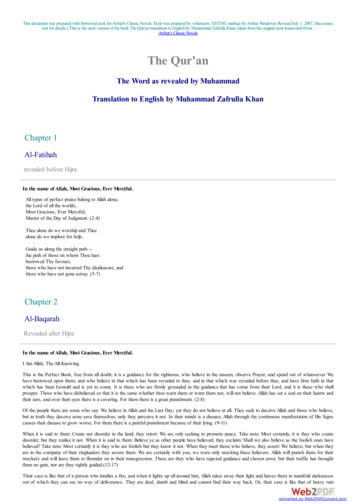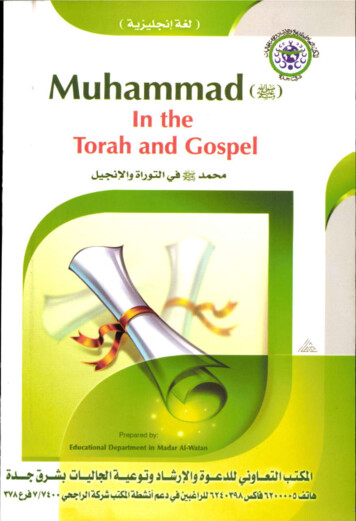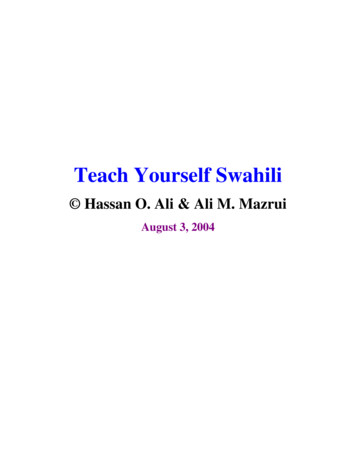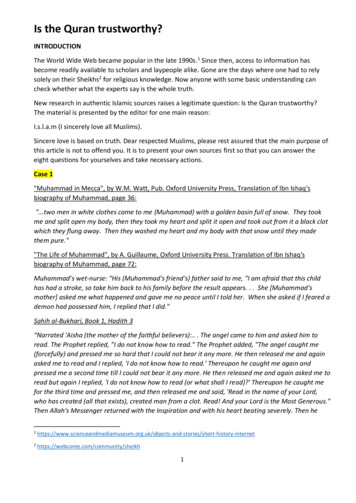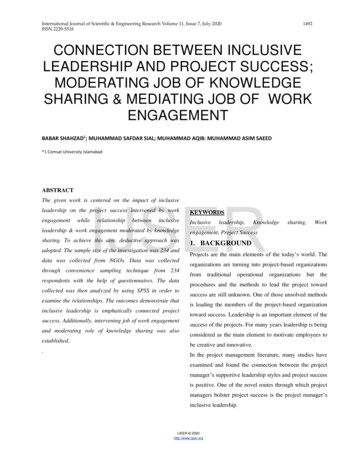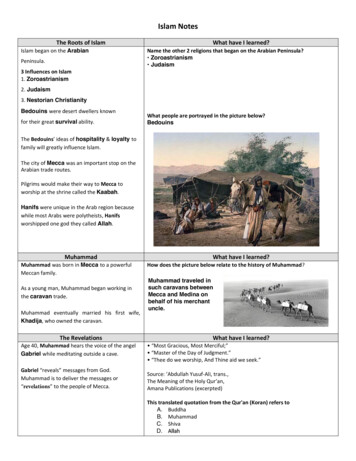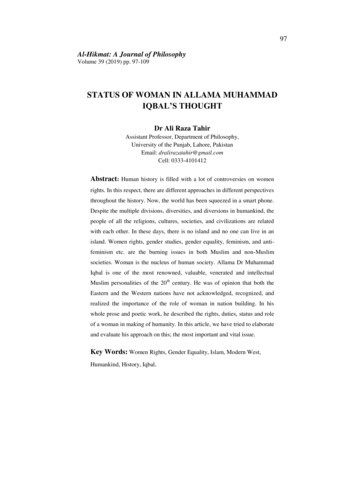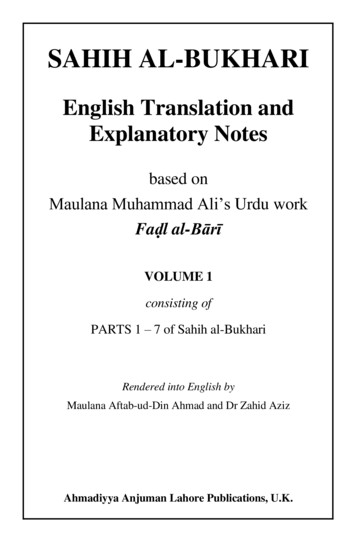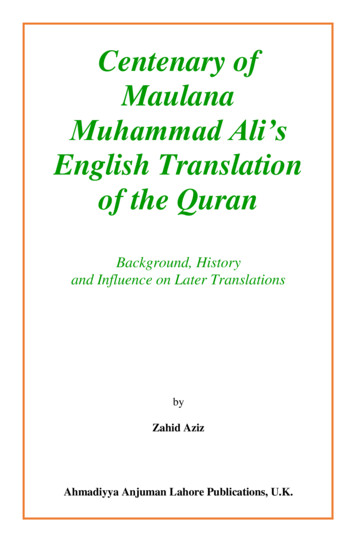
Transcription
Centenary ofMaulanaMuhammad Ali’sEnglish Translationof the QuranBackground, Historyand Influence on Later TranslationsbyZahid AzizAhmadiyya Anjuman Lahore Publications, U.K.
CENTENARY OFMAULANA MUHAMMAD ALI’SENGLISH TRANSLATIONOF THE QURAN
“My work was a work of labour. For every rendering orexplanation, I had to search Hadith collections, Lexicologies, Commentaries and other important works, and everyopinion expressed was substantiated by quoting authorities.Differences there have been in the past, and in future toothere will be differences, but wherever I have differed I havegiven my authority for the difference.Moreover, the principle I have kept in view in this Translation and Commentary, i.e., seeking the explanation of aproblematic point first of all from the Holy Quran itself, haskept me nearest to the truth, and those who study the Quranclosely will find very few occasions to differ with me.”— Maulana Muhammad Ali, writing in the Preface to the Revised1951 Edition of his English Translation and Commentary of the Quran,on why reviewers found that his 1917 edition was followed by laterMuslim translators (see also page 46).
Centenary of MaulanaMuhammad Ali’sEnglish Translation ofthe QuranBackground, Historyand Influence on Later TranslationsCompiled byZahid AzizAhmadiyya Anjuman Lahore Publications, U.K.2017
Published in 2017 by:Ahmadiyya Anjuman Lahore Publications, U.K.15 Stanley Avenue, Wembley, U.K.HA0 4JQWebsites: il.cominfo@ahmadiyya.orgCopyright 2017 Zahid AzizAll Rights Reserved.This book is available on the Internet at the link:www.ahmadiyya.orgISBN: 978-1-906109-65-3
PrefaceThis booklet has been compiled to mark the centenary of the publication of the English translation of the Quran, with extensive commentary, by Maulana Muhammad Ali in 1917. It was, in any practical sense, and in terms of theological scholarship, the first Englishtranslation of the Quran by a Muslim. It was certainly the first to bepublished and to be available in Western countries. Some thirtyyears after it first appeared, it was thoroughly revised by MaulanaMuhammad Ali. It is now a century that it has continued to be reprinted and re-published in different formats, most recently also indigital editions. His translation and commentary has also been usedas the basis for producing translations into several other languages.Later English translations by Muslims were influenced by thiswork, as we show in the present booklet. In fact, this translationpaved the way for them since it broke through the barrier imposedby the orthodox scholars of Islam who held that the Quran must notbe translated and who opposed the appearance of any such work.The most remarkable fact is that a movement which is insignificant in number and meagre in resources, and faces hostility fromwithin the Muslim world and from outside it, has been able to maintain this translation in existence and spread it widely all over theworld for a century.In chapter 1 of this book, we begin by tracing the source ofinspiration which led to the producing of this translation and explain the need for such a work. Then its history at Qadian is described till the events of March 1914 which led to the establishmentof the Ahmadiyya Anjuman Isha‛at Islam at Lahore. Continuing the1
2PREFACEhistorical account, chapter 2 covers the completion of the translation after the move to Lahore and its printing and publication fromWoking, Surrey, England. It goes on to quote many of the reviewswhich appeared both at that time and in later years. Brief mentionis also made in this chapter of the Maulana’s Urdu translation andmassive commentary, and the English editions without Arabic text,all these appearing in the 1920s.In chapter 3 there is a somewhat detailed examination of therelationship of the Maulana’s translation with certain well-knowntranslations by other Muslims which appeared afterwards. It showsreally the great debt which these translators owed to MaulanaMuhammad Ali.Chapter 4 relates the work of thorough revision of his translation and commentary which the Maulana carried out in the years1947–1951 to produce the 1951, fourth revised edition. It brings thesubject up to date with some details of the subsequent reprints andeditions after the 1951 revised translation.Chapter 5 gives excerpts from the writings of Hazrat MirzaGhulam Ahmad on the importance of the Quran to the world, Muslim and non-Muslim. It was his emphasis on the status, qualitiesand role of the Quran which inspired and motivated the pioneers ofthe Lahore Ahmadiyya to undertake the task of presenting theIslamic scripture to the world.In an Appendix are displayed images of title pages of variouseditions of Maulana Muhammad Ali’s translations of the Quran andsome typical pages from inside them.The information brought together and compiled in this booklet,much of it not generally known, will be found indispensable for anaccurate assessment of the history of the translation of the Quraninto English.Zahid Aziz, DrAugust 2017
ContentsPreface. 11. Work on the Translation . 5Founder of the Ahmadiyya Movement sets goal. 5Starts work on translating. 9Death of Maulana Nur-ud-Din and subsequent events 142. Publication and Reviews . 17Completion and publication of the English Translationof the Holy Quran . 17As being the “first” English translation by a Muslim. 22Authorities, sources and principles of interpretation . 23Reviews . 24Muhammad Ali Jauhar . 26Later reviews . 29Without Arabic text edition . 31Urdu translation Bayan-ul-Quran . 313. Later translations . 35Hafiz Ghulam Sarwar . 35Abdul Majid Daryabadi rescued from agnosticism . 38Marmaduke Pickthall’s translation . 39Pickthall and Lahore Ahmadiyya leaders . 42Comparison of translations in The Moslem World . 44Criticism of “Ahmadiyya propaganda” . 46Abdullah Yusuf Ali’s translation . 49Translation by M.H. Shakir. 53Muhammad Asad and his Message of the Quran. 553
4CONTENTS4. Revised 1951 edition and later .69Sermon announcing completion of revision . 69Preface to the revised edition . 72Later reprints and editions . 745. Status and Role of the Quran .77Appendix: Illustrations .84Title page of the first edition . 84A typical page from the first edition . 85Photograph of cover and title page of first edition . 86Title pages of 1920 and 1928 editions . 87Typical page from Bayan-ul-Quran . 88Title page of the 1951 revised edition . 89Title pages of 1963 and 1973 editions . 90Title page of the year 2002 edition . 91Typical page from the year 2002 edition . 92Index .93
1. Work on the TranslationFounder of the Ahmadiyya Movement sets goalShortly after starting to establish the Ahmadiyya Movement, Hazrat Mirza Ghulam Ahmad, the Founder, wrote in 1891 of his objective to present Islam to the West, in order to counter the mass ofcriticism directed at it both by Christian missionaries and modernthought. Appealing to the general Muslim community to renderhim help and assistance, he wrote in his book Izala Auham:“I have been asked what should be done to spread the teachings of Islam in America and Europe It is undoubtedlytrue that Europe and America have a large collection of objections against Islam, inculcated through those engaged in[Christian] Mission work, and that their philosophy and natural sciences give rise to another sort of criticism. Tomeet these objections, a chosen man is needed who shouldhave a river of knowledge flowing in his vast breast andwhose knowledge should have been specially broadenedand deepened by Divine inspiration. This work cannot bedone by those who do not possess comprehensive vision I would advise that writings of an excellent and highstandard should be sent into these countries. If my peoplehelp me heart and soul, I wish to prepare a commentary ofthe Quran which should be sent to them after it has beenrendered into the English language. I cannot refrain fromstating clearly that this is my work, and that definitely noone else can do it as I can, or as he can who is an offshootof mine and thus is included in me.” 1The Founder of the Ahmadiyya Movement thus made it as one5
6CENTENARY OF TRANSLATION OF THE QURANof his most important goals to have the Quran translated into English, with a commentary, and presented to the West. Moreover, hedeclared that he would re-establish the long-neglected, right principles for understanding the Quran. The resulting true knowledge ofthe teachings of this Holy Book would equip Muslims to presentthe Quran to the modern world in a way that would satisfy its doubtsabout faith and religion and answer its objections to Islam. We summarise the principles which he taught in chapter 5 of this book.At that time, the only English translations of the Quran that existed had been produced by British Christian critics of Islam. Thefirst one was by George Sale, published in 1734, followed by Rev.J.M. Rodwell’s translation in 1861, and Prof. E.H. Palmer in 1880.The first two were well-known, while Palmer’s work appeared inthe Sacred Books of the East series (volumes 6 and 9). These translators represented the Holy Prophet Muhammad as an imposter, deceiving the public in his claim to be receiving revelation, as suffering from mental disorders and serious moral flaws, and as one whowas motivated by his low and base desires.George Sale, in his note ‘To the Reader’, writes that, except forthose who have a very low opinion of Christianity or very littleknowledge of it, no one “can apprehend any danger from so manifest a forgery” as the Quran (p. iii). He goes on to add that it isProtestants alone, among Christians, who “are able to attack theKoran with success; and for them, I trust, Providence has reservedthe glory of its overthrow” (p. iv). On the next page, he refers to theHoly Prophet in these words: “for how criminal soever Muhammadmay have been in imposing a false religion on mankind” (p. v).According to Rodwell, while “in all he did and wrote, Muhammad was actuated by a sincere desire” to reform his countrymen,but the earnestness of his convictions led him to use “any means,not even excluding deceit and falsehood” (p. xxi, xxii). He adds thatthe Holy Prophet “was probably, more or less, throughout his wholecareer, the victim of a certain amount of self-deception. A cataleptic(or, epileptic) subject from his early youth, born — according to thetraditions — of a highly nervous and excitable mother, he would be
1. WORK ON THE TRANSLATION7peculiarly liable to morbid and fantastic hallucinations, and alternations of excitement and depression” (p. xxii). In his translation,Rodwell writes in a footnote near the end of the chapter ‘Joseph’ ofthe Quran, quoting the opinion of Sir William Muir, that the HolyProphet, in presenting the events of Joseph’s life as having beenrevealed to him, “must have entered upon a course of wilful dissimulation and deceit in claiming inspiration for them” (p. 292).In case of Palmer, in his Introduction he acknowledges that, ifwe consider the following that the Holy Prophet attracted, thisproves “that he could have been no mere impostor” (p. xlvi), butspeaking of his first revelations he writes: “From youth upwards hehad suffered from a nervous disorder the symptoms of which are almost always accompanied with hallucinations, abnormal exercise of the mental functions, and not unfrequently with a certainamount of deception, both voluntary and otherwise. Persons afflicted with epileptic or hysterical symptoms were supposed by theArabs, as by so many other nations, to be possessed Darkthoughts of suicide presented themselves to his mind ” (p. xx, xxi,xxii).It is quite evident that these translators proceeded with the belief that the Quran, although it may contain some good, was nonetheless at its root a product of deception and mental disorder of theHoly Prophet. They have then tried to find support for their preconceptions when explaining various passages of the Quran. As thiswas leading to a gross misrepresentation of Islam, Maulana Muhammad Ali wrote as follows in the Preface to his English translation of the Quran:“That a need was felt for a translation of the Holy Book ofIslam with full explanatory notes from the pen of a Muslimin spite of the existing translations is universally admitted.Whether this translation satisfies that need, only time willdecide.” 2In 1891, when the Founder of the Ahmadiyya Movement wroteof his desire to have the Quran translated into English and sent toWestern countries, he did not know Maulana Muhammad Ali, who
8CENTENARY OF TRANSLATION OF THE QURANwas then a teenager at school. He joined the Ahmadiyya Movementin 1897, and three years later decided to devote his life to serve thecause of Islam under the tutelage of the Founder. Shortly thereafter,Hazrat Mirza Ghulam Ahmad announced his intention to start amagazine in English, aimed at a Western readership as well as English-educated Muslims in India. In this announcement, he expressedhis anxiety and unbearable pain at the fact that “all those truths, thespiritual knowledge, the sound arguments in support of the religionof Islam”, which he was presenting to people in Urdu and to someextent in Arabic, “have not yet benefited the English-educated people of this country or the seekers-after-truth of Europe.” He appointed Maulana Muhammad Ali as editor of this magazine, and itwas launched in January 1902 with the title The Review of Religions. How this equipped him to produce, later on, his Englishtranslation of the Quran is mentioned by him in his Preface to therevised, 1951, edition of that translation. Replying to a Christianmissionary critic, he writes:“For full nine years before taking up this translation I wasengaged in studying every aspect of the European criticismof Islam as well as of Christianity and religion in general, asI had specially to deal with these subjects in The Review ofReligions, of which I was the first editor. I had thus an occasion to go through both the higher criticism of religion byadvanced thinkers and what I may call the narrower criticism of Islam by the Christian missionaries who had no eyefor the broader principles of Islam and its cosmopolitanteachings, and the unparalleled transformation wrought byIslam.” 3By 1907 the need for an English translation of the Holy Quranby a Muslim was being widely felt among the educated Muslims,and many Indian newspapers were alluding to it. There was a proposal by two well-known Muslim figures living in the U.S.A., Maulana Barkatullah of Bhopal (d. 1927) and Alexander Russell Webb(d. 1916), that they would translate the Quran into English if Muslims of India could raise the funds for them to do so. The editor ofthe Ahmadiyya community newspaper Al-Hakam wrote an articlein this connection in August 1907, in which he stated:
1. WORK ON THE TRANSLATION9“I do not see any option but to accept that an English translation of the Quran is a dire necessity, but to do this work ascholar is required who, on the one hand, if not a thoroughmaster of the entire breadth of the Arabic language, can atleast be called a specialist of Arabic, and along with this heshould have full command over the English language andcomplete mastery in writing it. Besides this, he should havea bond of attachment and love with God the Most High;moreover, his heart should be full of fervour for the propagation of Islam and pain at its present condition In addition, he should be thoroughly acquainted with the needs ofthe time and be fully aware of all the objections againstIslam that are put forward by heretics, atheists, philosophers, Arya Hindus, Christians, scientists and others, so thatin regard to those places in the Quran where these peoplehave stumbled, he should show the light of guidance.”He adds that such a suitable man is Maulana Muhammad Ali:“ it is a fact, which, if people do not realise it now, theywill do so in the future, that this revered person is the worthyyoung man Maulvi Muhammad Ali, M.A. By writing in defence of Islam and expounding its truth through The Reviewof Religions he has established the reputation of his pen inAsia and Europe so firmly that figures like Russell Webband philosophers like Tolstoy acknowledge that the concepts of Islam presented in this magazine give satisfactionto the soul. In Europe and America, articles of this magazinehave been read with great interest and valued very highly.”4As The Review of Religions was being circulated to the Western English-speaking world, and sent as far as the USA, the producers of this magazine must undoubtedly have realized the needfor a reliable English translation of the Quran from the Muslimpoint of view, and they may well have received enquiries fromreaders as to a recommended translation that they could study.Starts work on translatingThe Founder of the Ahmadiyya Movement had passed away inMay 1908 and Maulana Nur-ud-Din had become Head of theMovement. The Maulana was an illustrious scholar of Islam, as
10CENTENARY OF TRANSLATION OF THE QURANwell as being deeply learned in other branches of religious and secular knowledge. Before joining the Ahmadiyya Movement in 1889he had travelled widely in pursuit of religious knowledge and hadstayed in Makkah and Madinah for some time. For his learning, hewas held in high esteem by eminent Muslims outside the Ahmadiyya Movement. He had a particularly deep knowledge of, and lovefor, the Quran which he had studied for many years. His principleof understanding the Quran was that the interpretation of any passage in the Quran should be sought, in the first place, from otherpassages within this scripture itself. The Quran explains itself. Itmust also be studied in the light of reason and modern knowledge.The traditional sources, which are Hadith books and classical commentaries, are a valuable help, but they cannot be used to overrideand undo anything which is clear from the Quran.It was under the guidance of Maulana Nur-ud-Din that Maulana Muhammad Ali started work on translating the Quran intoEnglish in 1909 at Qadian where he lived and worked. At that time,he was secretary of the central executive committee which managed the affairs of the Ahmadiyya Movement (Sadr Anjuman Ahmadiyya), and was also editor of The Review of Religions. Thesewere his official duties. In May 1909, he placed the proposal fortranslating the Quran before this committee since, after the completion of the work, it would be funding its publication. He indicatedin his proposal that if the committee were unable to bear the expenses of the publication “it is possible that Allah will provide someother means for me”.5 The work of translation he carried out on hisown, according to his own judgment, under the advice and guidanceof Maulana Nur-ud-Din.Maulana Muhammad Ali worked on the translation often athome during the night. If no electricity was available, he worked bycandle light at night. Whenever he went on leave, he took the workwith him. Long afterwards, it was stated in the Foreword to the1963 edition, which appeared after the Maulana’s death:“Work on the first edition of the English translation of theQuran took him seven long years (1909–1916). The amountof original research that went into tracing the meanings of
1. WORK ON THE TRANSLATION11the words and verses, finding the underlying sense of Sections and Chapters, and linking it up with the preceding andsucceeding text, so that the whole of the Quran was shownto have the thread of a continuous theme running through it— it is simply staggering to think of all this stupendous andmost taxing labour put in single handed, day after day, forseven long years. But that is exactly what made MaulanaMuhammad Ali’s translation the boon of the world of scholarship in the West as well as the East when it appeared inprint in 1917. It was a pioneer venture breaking altogethernew ground, and the pattern set was followed by all subsequent translations of the Quran by Muslims. There is noattempt at pedantry or literary flourishes. Nor is there anypandering to preconceived popular notions or a bid forcheap popularity. It is a loyal service to the Word of Godaiming at scrupulously honest, faithful rendering.” 6In a report to the committee in 1911, Maulana Muhammad Aliexplained that “to publish only a translation is not very useful andthe following additions are necessary”. Apart from footnotes, thesewould be an introductory note to each chapter, a summary of eachsection within a chapter, and an introduction to the whole work.7Maulana Nur-ud-Din had taken a great interest in the translation. Maulana Muhammad Ali used to visit him regularly to read tohim from the place he had reached in the translation, and take guidance from him particularly as regards the commentary.An incident is reported, probably from 1912, that whenKhwaja Kamal-ud-Din came to Qadian after one of his lecture toursof India, he informed Maulana Muhammad Ali that the Nadwat-ulUlama (a well-known Islamic instruction institution based in Lucknow) was having the Quran translated into English by Syed HusainBilgrami (eminent Muslim educationist and civil servant),8 and thatMaulana Abul Kalam Azad was writing an Urdu commentary ofthe Quran. So, asked Khwaja Kamal-ud-Din: “Who would pay anyattention to an English or Urdu translation by you?” Maulana Muhammad Ali mentioned this to Maulana Nur-ud-Din, who replied:“Let them do whatever they are doing. You do your work. Recognition is ordained by God. Whichever translation is accepted by
12CENTENARY OF TRANSLATION OF THE QURANGod, that is the one which will attain renown in the world. Duringthe time of Imam Malik, sixty collections of Hadith called Muwattawere compiled, but recognition was given only to the Muwatta ofImam Malik. None of the others can be found anywhere today, andpeople only know of the Muwatta of Imam Muhammad after thatof Imam Malik. Even the name of any other is not known.” 9Even when Maulana Nur-ud-Din fell so critically ill that speaking exhausted him, in that state of the most serious ailment, hewould still receive Maulana Muhammad Ali daily to listen to histranslation and notes and give advice. Speaking of those last days,many years later, Maulana Muhammad Ali said:“It was my good fortune that I had the opportunity to learnthe Quran from him even in those days when he was on hisdeath bed. I used to read out to him notes from my Englishtranslation of the Holy Quran. He was seriously ill, but evenin that state he used to be waiting for when Muhammad Aliwould come. And when I came to his presence, that samecritically ailing Nur-ud-Din would turn into a young man.The service of the Quran that I have done is just the resultof his love for the Holy Quran.” 10The last days of the life of Maulana Nur-ud-Din were chronicled every few days in the Ahmadiyya community newspapers inthe form of the latest reports of his condition and engagements onhis sick bed. We reproduce below some extracts from these:119 February 1914 — He said: “Ask Maulvi MuhammadAli sahib about my knowledge of the Quran. Having workedvery hard he comes with hundreds of pages and I abridgethem. He sometimes says that my opinion is better than allresearch.” Then he said: “ Maulvi sahib has pleased mevery much, I am so happy. What wonderful research he hasdone on Gog and Magog He has searched through encyclopaedias.”14 February 1914 — He is still in a critical condition heis getting weaker by the day. He listens to Maulvi Muhammad Ali sahib’s translation of the Quran daily. His courage and determination is very great and his love for the
1. WORK ON THE TRANSLATION13Quran is unequalled. He says: “It is the Quran which is thesource of my soul and life.”16 February 1914 — When Maulvi Muhammad Ali sahib comes to read the notes of the Holy Quran to him, sometimes even before he begins Hazrat sahib [i.e., MaulanaNur-ud-Din] gives a discourse about the topic of the translation of the day and says that throughout the night he hasbeen consulting books and thinking about it. He does notmean that he actually reads books; what he means is that hekeeps running over in his mind what is written in commentaries of the Quran and books of Hadith. Sometimes hequotes from books of Hadith or the Bible, and does it perfectly accurately. He says again and again that his mind isfully healthy and it never stops working on the Quran.18 February 1914 — While he was in a state of extremeweakness Maulvi Muhammad Ali sahib came as usual toread out notes from the Holy Quran. Hazrat sahib said:“It is all the grace of God. What has happened is by Hisgrace and what will happen will be by His grace.” Thenhe added: “This translation will inshallah be beneficial inEurope, Africa, America, China, Japan and Australia.”22 February 1914 — He was very cheerful today. Whentold that Maulvi Muhammad Ali sahib had come to read tohim the [translation and notes of the] Quran, he said: “He ismost welcome. Let him read it. Does my brain ever get tiredof it?” Then he pointed towards his bed and said: “LetMaulvi Muhammad Ali sahib come near me.” Then headded: “He is very dear to me.”An announcement dated 3 March 1914, that is, ten days beforethe death of Maulana Nur-ud-Din, regarding the English translationof the Quran, was published as an appendix to The Review of Religions, February 1914 issue. On the first page there is a statementby Maulana Nur-ud-Din in which he says:“Up to today I have listened to the notes of twenty-threeparts, which is more than three-quarters of the work. Even during my illness, I have been listening to the notes
14CENTENARY OF TRANSLATION OF THE QURANand dictating as well. I have spent all my life, from childhood to old age, studying the Holy Quran and ponderingover it, and Allah, the Most High, has given me the kind ofunderstanding of His Holy Word that very few other peoplehave. I hope for grace from Allah that He will not let go to wastemy efforts in the service of His Word. I am also sure thatthose people who have a connection with me and who loveme have also been granted the zeal to serve the Quran. This translation will inshallah prove to be beneficial in Europe, Africa, America, China, Japan, Australia, etc.”A footnote to this announcement provided an update, saying:“By the time this announcement was printed, the footnotes of 26parts had been completed.”Later, when the translation was published, the following tributewas paid by Maulana Muhammad Ali in the Preface at the pointwhere he acknowledged his sources:“And lastly, the greatest religious leader of the present time,Mirza Ghulam Ahmad of Qadian, has inspired me with allthat is best in this work. I have drunk deep at the fountain ofknowledge which this great Reformer — Mujaddid of thepresent century and founder of the Ahmadiyya Movement— has made to flow. There is one more person whose nameI must mention in this connection, the late Maulawi HakimNur-ud-Din, who in his last long illness patiently wentthrough much the greater part of the explanatory notes andmade many valuable suggestions. To him, indeed, the Muslim world owes a deep debt of gratitude as the leader of thenew turn given to the exposition of the Holy Quran. He hasdone his work and passed away silently, but it is a fact thathe spent the whole of his life in studying the Holy Quran,and must be ranked with the greatest expositors of the HolyBook.” 12Death of Maulana Nur-ud-Din and subsequent eventsOn 13 March 1914 Maulana Nur-ud-Din died. With that came aturning point in the life of Maulana Muhammad Ali and his literaryand missionary activities, changing their course forever. A split and
1. WORK ON THE TRANSLATION15schism took place in the Ahmadiyya Movement when MirzaBashir-ud-Din Mahmud Ahmad, a son of the Founder, was controversially made head of the Movement by his supporters. He proclaimed the doctrine that a person is not a Muslim unless he believes in, and formally acknowledges, the claims of Hazrat MirzaGhulam Ahmad. In his view, a Muslim who did not accept HazratMirza Ghulam Ahmad was, in terms of Islamic theology and law,exactly like the non-Muslim who does not accept the Holy ProphetMuhammad. He declared that social and community relations between members of the Ahmadiyya Movement and other Muslimsshould be on the basis that the former are Muslims and the latter arenon-Muslims just as Christians or Hindus are non-Muslims.Maulana Muhammad Ali and many others in the AhmadiyyaMovement refused to accept these pronouncements, which they regarded as being contrary to the teachings of Islam, and of theFounder of the Ahmadiyya Moveme
cation of the English translation of the Quran, with extensive com-mentary, by Maulana Muhammad Ali in 1917. It was, in any prac-tical sense, and in terms of theological scholarship, the first English translation of the Quran by a Muslim. It was certainly the first to be published and to be available in Western countries. Some thirty


